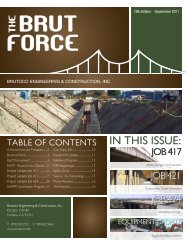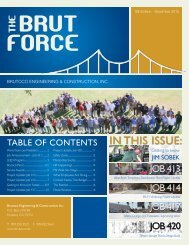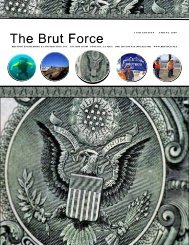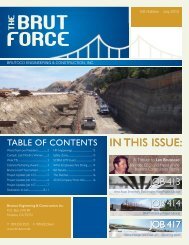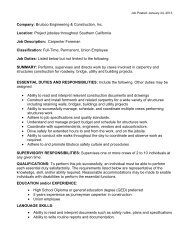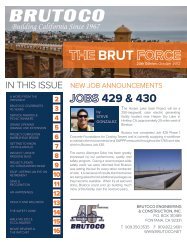Brut Force -14th Edition - Brutoco
Brut Force -14th Edition - Brutoco
Brut Force -14th Edition - Brutoco
- No tags were found...
Create successful ePaper yourself
Turn your PDF publications into a flip-book with our unique Google optimized e-Paper software.
By Sharee’ AndradeJOSE MARTINPromoted to Senior Structures EstimatorJose Martin is a longtime <strong>Brut</strong>oco team member. He has been with <strong>Brut</strong>oco since July 1994. In July 2009, he waspromoted to Senior Structures Estimator and he is now stationed in the Fontana office. Jose is no stranger to estimating,and during his career with <strong>Brut</strong>oco he has assisted our Estimating department several times.BOB BRAUNPromoted to Project SuperintendentBob Braun has been with <strong>Brut</strong>oco since June 2005. He has worked his way up from Intern to Project Engineer, and nowto Project Superintendent. His promotion became effective July 2009, and his first assignment was the completion of Job#398 SCRRA Colton Facilities.AMANDA JARACZEWSKIPromoted to Full-Time Project EngineerAmanda Jaraczewski has been with BEC off and on since 2008. She started out as a Summer Intern and was promoted toa full-time Project Engineer on January 18, 2010, after she graduated from Purdue University in Indiana. She is currentlyworking on Job #417 Orange Line Extension.JON MERRYMANPromoted to Full-Time Project EngineerJon Merryman has been with <strong>Brut</strong>oco since June 2007. He began as an Intern and has worked off and on depending onhis school schedule. Jon graduated in December 2009 from Cal Poly Pomona. As of January 2010, he is stationed in theFontana office.ROBERT MULLEN joined <strong>Brut</strong>oco on January 11, 2010 and is currently working out of the Fontana office.He is preparing and implementing a Quality Assurance/Quality Control (QA/QC) Program for <strong>Brut</strong>oco, with his initial projectassignment at Job #417 Orange Line Extension.Robert comes to us with over 20 years of experience in QA/QC and construction.PEARL ESPINOZA joined <strong>Brut</strong>oco on November 12, 2009. Pearl is the Project Secretary at Job #413West Basin Desalination.She comes to us with many years of clerical experience and has previously worked for steel and trucking companies.JOANNE SCHULTZ returned to <strong>Brut</strong>oco on January 4, 2010 to take on the role of SeniorAdministrative Manager and is working out of the Fontana office. Her responsibilities include legal, claims andinsurance, as well as providing oversight for scheduling, HR and marketing.She has more than 19 years of experience in project controls, planning, scheduling, coordination and marketing.
Soo & SunLeeJune 6, 2009Nathan & KimMontgomeryJune 13, 2009Jon & RoyceMerrymanSeptember 12, 2009Laurence & MarisaFortinFebruary 14, 2010Congratulations to MOISES AND LINDSEY ONTIVEROS for the birth of their new daughter, JocelynMarie Ontiveros. Jocelyn was born on October 26, 2009 at 4:22 a.m. She weighed 6 lbs 7oz and was 18 ¼” long. Nathan and Kim Montgomeryhiking on Mt. Baldy, CASharee’ Andrade and daughter,Alexee, riding their quad atOcotillo Wells, CADon Brake, Nathan & Kim Montgomery, David Buck and Mike B. at the top ofMt. Whitney, CA5
#414 (…...Continued)compliance with regulatory agencies including theArmy Corps of Engineers, US Fish and WildlifeService, and the Department of Fish and Game. Asa condition of working near these biologicallysensitive areas, Caltrans has agreed to plant over140 oak trees in locations adjoining the project andthroughout Chino Hills State Park.The project also crosses through geologic strataknown to contain fossils. When working in theseareas, paleontological monitors are required to bepresent in the excavation areas to collect anydinosaur bones that may be found. Some teammembers from <strong>Brut</strong>oco have been trained torecognize the fossils so they are not destroyedduring the work.The biggest challenge of the project is the extremelyaggressive time schedule with which it was bid.This project was bid as an A+B contract, whichmeans bidders submit a bid dollar amount (A) andthe number of working days they will complete theproject (B). <strong>Brut</strong>oco’s bid of $35.5M was third lowestamong bidders, but when combined with our bid of 300 calendardays we were determined to be low bidder and awarded thecontract.The entire project must be worked simultaneously during aforecast strong El Niño storm season that exposes <strong>Brut</strong>oco toweather-related delays and damages while limiting the amountof work that can be accomplished.As of January, several operations are concurrently taking place.<strong>Brut</strong>oco is forming and pouring retaining walls, installingabutment footings and walls at multiple bridges, setting girdersConstructing the soil nail wall.and falsework at Coal Canyon Bridge, excavating and placing fillsfor soil nail walls, backfilling retaining walls, and installing thestorm drain system at the west end of the project.The major subcontractors currently working are Foundation Pileinstalling pile, AVAR installing soil nails, and Select Electricinstalling the temporary electrical system.There is a lot of work to finish over the next few months, butwith the continued support of the office staff and shop, weexpect to successfully complete the project. •DO YOU KNOW WHICH OF THE TEN BRUTOCO EMPLOYEES BELOW HAVE THE MOST SENIORITY?Number the employees listed below, 1 to 10 with #1 being the employee who has worked for <strong>Brut</strong>oco the longest(Hint: #2 is an employee who’s claim to fame is that he has written the bridge number on every bridge <strong>Brut</strong>oco has ever built!)#1 Len <strong>Brut</strong>ocao___ Mike Bergeon___ Mike Fenley___ Jose Jimenez___ Ronnie Neal___ Misael “Chato” Noguera___ Alex Ramirez___ Jesus “Jesse” Ramirez___ Jack Rudometkin___ Augustine “Chito” SotoLen<strong>Brut</strong>ocaoMisael“Chato”NogueraMikeBergeonAlexRamirezMikeFenleyJesseRamirezJoseJimenezJackRudometkinRonnieNealAugustine“Chito”SotoGet your answers to TeresaMaxwell in the Fontana Officeby MARCH 31 ST and be sure toput your name on your entryform. Drawing of correct entrieswill be on April 1.Email tmaxwell@brutoco.netor fax (909) 350-6820Winner from thedrawing will get a$25 Dominos Pizzagift certificate.9
1 ST PLACE:$$$ Smells like Money $$$Captain: Angelo VeronesiRick Belmontes, Robert Ahumada,Matt Tonkovich, Guillermo Davalos,Anthony Cortez Junior 2 ND PLACE:Colton Stud MuffinsCaptain: Bill SneeRyan Tovar, Ramon Quintero,Richard Nava, Alex Ramirez,Fred Lichtenstern1 ST PLACE:<strong>Brut</strong>oco BabesCaptain: Nanette MurphyTeresa Maxwell, Dania Imler,Sharee’ Andrade, Janet Bradford,Jamie Chandler1 ST PLACE: Victoria Vasquez2 ND PLACE: Cheryl Maxwell3 RD PLACE: Amanda Belmontes1 ST PLACE: Joe Sandoval & Chito Soto2 ND PLACE: Jose Martin & Larry Smith3 RD PLACE: Rick Belmontes & Al Benavente1 ST PLACE: Chad & Amanda Belmontes2 ND PLACE: Mike & Nanette Murphy3 RD PLACE: Jose & Monica Martin(The most nails in 60 sec.)1 ST PLACE: Francisco Alcala (24)2 ND PLACE: Rafael Cabral (21)3 RD PLACE: Jaime Reyes (20)(The most nails in 30 sec.)1 ST PLACE: Cheri Grosz (9)2 ND PLACE: Sharee Andrade (8)3 RD PLACE: Lesa Bryant (7)11
By Tom MorrisonRick Belmontes coordinates pipe installationon Old Lewis Rd.The SalinityPipeline was aninteresting projectfor <strong>Brut</strong>oco. It involvedreturning to a previous joblocation, BEC Job #314which was The HuenemeRd. box girder bridge overthe Calleguas Creek inCamarillo, CA.This new project was toinstall a portion of pipe of the Calleguas Salinity ManagementProject (SMP). This is a regional pipeline that will collect saltywater generated by groundwater desalting facilities and excessrecycled water and convey that water for reuse. Any unused saltywater will be safely discharged to the ocean, where natural salt levelsare much higher.BEC Job #314—Hueneme Rd. Box Girder Bridge, (1977)Phase 1D of the SMP was to install large sections of a 52 inchdiameter HDPE pipeline on Lewis and Hueneme Roads. The pipelinehad to be reduced to two 20 inch HDPE lines that were pulledthrough the Hueneme Rd. box girder bridge. Other sections of theunderground pipe installed by BEC were comprised of steel and PVC.BEC also constructed twounderground concretevaults in a shoredexcavation that requireddewatering.Angelo Veronesi and Fred Lichtenstern carefully plantheir next move during the installation of a 300 footsection of 52 inch HDPE.The Salinity project waschallenging but wasmade more interestingbecause during thecourse of the work, theagency, CalleguasMunicipal Water District(CMWD), called on<strong>Brut</strong>oco to respond to anemergency repair of a 12inch buried water main innearby Thousand Oaks,CA. Ironically, our ownunderground utilitysuperintendent, AngeloVeronesi, had previouslybuilt portions of thiswaterline as well. Angelohad the task to get thisline leak located andrepaired in an aroundthe-clockworkoperation.Several booms and rollers were required to move the large sectionsof pipe that were fused together on-site.Anthony Cortez rigs pipe in the critical installation processBenny Antuiano works on the new manholesinstalled in the bridge deck which he had helpedpour on Job 314.<strong>Brut</strong>oco’s professionalproject team made thejob(s) a success interms of safety,schedule, profitabilityand owner relations.A job well doneAbraham Luna tests water turbidity forguys! • Bill Snee inside the bridgedewatering discharge into Calleguas Creek.
By Tom Morrison<strong>Brut</strong>oco’s Job 411 was a projectthat required modifications to anexisting filter system of theDonald C Tillman sewage treatment plant inVan Nuys CA. The filtration system modifiedwas the tertiary stage of water treatment inthe plant. The water that is discharged fromthis stage of treatment is classified as”reclaimed” water suitable for discharge intothe LA’s waterways and used for irrigationpurposes.The scope of work included demolition ofexisting conventional sand filters in sixteenbasins, modifications of existing concretestructures, installation of the City-suppliedAqua Diamond Filters, replacement of anexisting transformer, overhead backwash pipesystem upsizing, all associated piping,electrical, and instrumentation for twoseparate operating systems called Phases 1& 2.The schedule for this project was veryaggressive as the liquidated damagesspecified were steep but <strong>Brut</strong>oco deliveredthe project to the City on time and withoutany time extensions. Some of the additionalchallenges (besides simply building theproject) were procuring equipment timelythat required a BEC hired inspection firm towitness manufacturing in distant locations likeTexas and Canada, building the work underthe jurisdiction of two separate City of LADepartment of Building and Safety permits,and the coordination of the startup of theequipment between BEC, the electrical /instrumentation subcontractor, the AquaDiamond filter supplier and the DCT plantoperations personnel. Despite thesechallenges, the commitment and coordinationefforts by all parties made the project asuccess.<strong>Brut</strong>oco’s excellent project teamwas responsible for building theproject on time, under budget andwithout incidents or injuriesThe first step was removing the old sand media filter and to retrofit the basins toaccept the new Aqua Diamond cloth filters for16 separate basins in Phase 1 & 2Installed diamond filter laterals and launders (left) <strong>Brut</strong>oco crews install the first travelingbridge in Phase 1 (Right)Traveling bridges (left) collect the filtered material and send it back to the headworksthrough the <strong>Brut</strong>oco-installed backwash piping system (as shown on right)There were over 30,000 man hours spent insix months and up to fifty- five <strong>Brut</strong>oco fieldemployees on the project daily during thepeak of construction. From the BECoperations manger to the administrative staffto the BEC foremen (more than ten of them)to all field crews involved, <strong>Brut</strong>oco can beproud of the effort and a job well done. •Newly installed system produces reclaimed water (left) The water is used for multiplepurposes including the irrigation of the Tillman Japanese Gardens located on thepremises (right)“A business that makes nothing but money isa poor business.”Henry Ford13
MIGUEL (MIKE) FENLEY is <strong>Brut</strong>oco’s Senior Vice President andGeneral Manager, as well as an ESOP Co-Trustee. He has beenwith <strong>Brut</strong>oco for 30 years on and off. Mike has worked as a CostEngineer, Project Engineer, Junior Estimator, Project Superintendent,Project Manager, StructuresEstimator, Structures Manager,Special Projects Manager and GeneralManager. You may have worked withMike when he was bidding a project,managing jobsite operations,developing company policies, or mostimportantly, approving your vacationrequests.Here are the answers to your questionsfor Mike:Where were you raised?I was raised in Calexico, California, a small town in the ImperialValley.What is the size of your family and theirnames?Wife Corinne, Daughter Michelle, Son Matthew, Dog Shadowand Beta Fish Jorge number 2 (Beta Fish Jorge 1 died).If you could go anywhere in the world, wherewould you go? Who would you bring? Howlong would you stay?Rome to see the Coliseum, Vatican and the canals with my wife.The trip would last a minimum of two weeks, longer if I can getmy vacation request approved.What kind of movies do you like?Action/Shoot’em Up/Blow’em Up. My favorite movie isHellfighters (1968) starring John Wayne. It’s the story of machooil well firefighters and their wives.What was your first pet, and its name?It was a goldfish named “Little Fish”. I won him at a county fairby tossing a ping pong ball into a fish bowl.What was the first career path you wantedwhen you were a child?I always wanted to be an engineer. I used to build mud bridgeswith 2x4’s and plywood. I’d run my toy cars and trucks acrossthe bridges until they broke.Did your father’ s career influence your decisionto work in construction?My Dad was a structure rep for Caltrans. Back then he was called a“Bridge Engineer” and Caltrans was known as “Division of Highways”.I’ve always wanted to build bridges and roads and my Dad helped megain the knowledge of how to do it.Where did you work before <strong>Brut</strong>oco?I worked for Caltrans and Santa Fe Rail Road (now a part of BNSF).Ifyou could jump in atime machine and chooseany career path youwanted what would it be?The same career path. I’ve enjoyed itand it’s been one hell of a ride.14
What is your favorite project you worked on and why?<strong>Brut</strong>oco Jobs #352 & #356. The RO Chino and ION Exchange projects.They were my favorite because it was something completely different for me.It brought new challenges since we were just starting to do Utility Groupwork.What is your least favorite project you worked on andwhy?The jobs I least enjoyed were the <strong>Brut</strong>oco jobs up north. The SanFrancisco/101 Freeway project comes to mind. It was all night work so gettinganswers from the owner was difficult. Traffic up there is worse than in LA!If you were not at <strong>Brut</strong>oco now where would you be?Retired. Living in the desert.If you could be any superhero, who would you be andwhy?That’s easy – Superman. He flies faster than a speeding bullet and is strongerthan a locomotive.Mike as a young boy (bottom, right) pictured with hisIf you were stranded on a deserted island, which fiveparents, Jack and Magdalena and younger brother,people (other than family) would you want to be thereNick.with you and why did you choose them?1. Andy Warhol – If your going to be on an island, you need somethingto do.2. John Wayne – A no-nonsense guy.3. Bob Marley – He didn’t have a care in the world and would keepeveryone calm.4. Tom Clancy – A good author.5. Henry Ford – He always wanted to figure how to make things faster and cheaper.Often upper management says that ‘our people are our greatestassets’. What ways do you think are most successful in protectingthe human assets at BEC, taking into account our current economicclimate?Challenging people and giving them opportunities to succeed. Most people want to succeedand better themselves, regardless of what the economic climate is.What is your favorite TV show?Mega Builder.Who have been the most influential people in your career at<strong>Brut</strong>oco?I have had three great people that have been influential in my career here. They are Len<strong>Brut</strong>ocao, Ronnie Neal and Ron Graves.What is your fondest memory at <strong>Brut</strong>oco?Being part of the team that built the Bullcreek project after the Northridge Earthquake in 1994.What changes would you like to see at <strong>Brut</strong>oco?I’d like to see more people held accountable for what they do and do not do, and not accept I’mworking on it with no progress. Do what you said you were going to do, do it right, get it doneby when you said you’d have it done.Streamline our overhead.I’d like to see the Ice Cream Social continue once a year, that way everyone hears directly fromthe President as to the state of <strong>Brut</strong>oco and plans for that year.Jack Fenley with his two sons, Mike(standing in back) and Nick.What gives you the most satisfaction in your current position?Being in a position to work with hardworking, smart people who want do the right thing and getthe job done.Being part of <strong>Brut</strong>oco’s growth from being just a highway and bridge builder to building utilityprojects and doing building work. I am looking forward to other great things to come.Knowing that every day, I come to work and try to make a difference; to make this place we alllive and work in a little better for us and our families.What brings you the most happiness in life?My family. •Mike’s kids, Michelle & Matt Fenley.Matt is proudly wearing the sameoutfit (Charro) that his Dad worewhen he was a boy, as picturedabove.15
By Laurence FortinDo you see safety as something that you are told to do,or something that has value to you?Our safety culture is the knowledge, beliefs andbehavior of our company and all of its employees, from thefield to the office. It is what we believe, but don’t necessarilysay. It’s knowing what is expected of us, and what we can getaway with. This culture is learned by us and passed along toour new hires.Four different safety cultures are outlined below in an excerptfrom an article by Robert Pater, Managing Director of StrategicSafety Associates and MoveSmart.How would you classify <strong>Brut</strong>oco’ssafety culture and your personal beliefsand behavior?1. <strong>Force</strong>d Safety Culture. Here, safety is “Done To”others—by command and control. These companies inherentlyview safety as a blockage to business so they do the leastnecessary to stay in compliance with regulating agencies.Managers similarly expect compliance from workers. Safetypeople are typically understaffed and can think of themselvesas safety police: enforcement first, surprise inspections tounearth violations. Punishment soon follows, so workers covertheir rears in accident investigations and audits.on self-monitoring more than external auditing. Motivationmoves toward recognition, beyond external incentives.Executives often actively sponsor new initiatives. Safetycommittees are active and have decision power, training, andoften a budget. Some employees become trained as catalystsof safety improvement (trainers, coaches, and reinforcementagents). There’s a strong focus on off-work safety training,with PPE to take home.This culture has significant internal drive to remain cuttingedge,pioneering new and effective initiatives and not restingon their laurels.Safety Culture Reflects Overall CultureSafety cultures strongly reflect overall culture. I’ve never seena strong organizational culture that had a weak safety culture,and vice versa. So by leading stronger safety culture, you canin turn move your company to higher ground in performance,profitability and morale. •2. Protective Culture, where safety is “Done For” workers.Performance is average. This type of company begins seeingsafety as important. They often proclaim, “Safety is #1!” (Theythen lose credibility when production or other pressures takefront seat.)They seek to make the workplace safe by controlling, topdown,benevolent parent-like, and to bypass the need for strictcompliance. Common thought process: “If everyone did asthey were directed, all would be well.” This culture is big onpolicies and procedures. And if one policy doesn’t get results,“experts” write even more explicit directives.<strong>Brut</strong>oco workers receive traffic control training at Job #401Emphasis is on engineering fixes, dealing with injuries afterthey’ve occurred, and incentives. This culture still seeks quickand cheap solutions to complex and longstanding problems(back belts, safety bingo).3. Involved Cultures are “Done With” employees — andwell done. Performance is above average. Managers see safetyas an opportunity to involve workers and boost morale.Emphasis goes beyond injury prevention to “soft benefits” —retention, building trust, receptivity to change, engagement,more. This culture trains supervisors and discusses off-worksafety. Training becomes geared to judgment, problemsolving,and skills. Involved companies approach behavioralauditing as a more positive process than do forced cultures.4. Integral Cultures are those where safety is “Done By”workers, for themselves. Performance is global class — andcontinuously watched. People see safety as energizing,interesting and practical.Self-regulation is the norm; people engage in safe actionseven when they know no one’s watching. This culture focusesTrench safety at #40116
THE RATCHETIsn’t it a little dangerous having both Larry Vogel and Paul Sullivan working so close to the golf course?B.Z. has been heard complaining that the new window in Fontana’s back door should havebeen about 10” lower… (Maybe our corporate window contractor, Richard Lawrence, can helphim out with this….)Good thing Ronnie Neal isn’t an Estimator looking for work . Ronnie can’t even find the bridges wealready have… Keep looking, Ronnie!Angelo has gone from being a turd-herder in L.A. to a manuresnifferin Kettleman City…. And speaking of Kettleman City,enquiring minds want to know, how did the fried turkeytesticles (local delicacy) taste?Jeff T…..Watch out for them birds!Ronnie did such a great job serving ice cream at the ice cream social,his new nick name is “Scoop Neal”.And speaking of the ice cream social, let’s NOT have that flavor next time.Craig Sperry has been chosen so many times recently for randomD.O.T. drug testing , it is going to drive himto drink!“Scoop Neal”“SOMETHING ABOUT CRAIG”….I wonderif Craig Maxwell recent weight loss is dueto him working the extra hours on thePrado bridge or his diet? Or could it behis newly acquired movie star status?!Jason Soto was recently putting stuff in storage here in Fontana andaccidently put his leg through the ceiling in Wing’s office. Jason wasn’tworried about breaking a leg however; he just wanted to make sure hedidn’t break a Wing!Craig at work on the set of “Something AboutSteve”Chato and Dania are now the official “Dumpster Divers” in Fontana...And speaking of dumpster diving, Chato and Dania have a question for Mike B.– Why are youthrowing away such good stuff?<strong>Brut</strong>oco’s accounting softwarePaul, Man-purse or Satchel?Mark B., Are you sure you put this one togethercorrectly?Fred L. is ready forEaster....or is thatEaster Dinner”?Hard at work17
he country’s 600,000 bridges, four million miles of roads, and 30,000 wastewater plants desperately needT attention. The solution isn’t patches, it’s an overhaul. Soon roads and power lines will fix themselves, and we’llmine energy from sewage. America’s 21st-century tune-up won’t happen overnight, but we could start reaping thebenefits within the next few years.Mess #1:TRANSPORTATIONBRIDGES THAT FLEX ON THE FLYTask: Upgrade the 26 percent of decrepit bridges.Status: Pedestrian versions exist; traffic bridges in 10 years.Regular bridges are fairly rigid structures that break down overtime from stress. “Tensegrity” structures disperse load over anest of tensed cables and compressed struts that allow them tobe both flexible and structurally rigid. Now the University ofCalifornia at San Diego is developing traffic-bearing tensegritybridges with feedback sensors to guide subtle adjustments incable length, which could alleviate the shifting stresses of anoverladen truck, counteract the vibration frequency of anearthquake, or disperse the load of a severed cable.TRACKLESS ELEVATED TRAINSTask: Add urban railways for a third the cost of conventionallight rail.Status: Texas A&M University’s Texas TransportationInstitute has offered free land for a two-mile test track.To save the multibillion-dollar cost of clearing 24-foot-wideswaths for new track, trainmaker Tubular Rail wants to shoottrains up to 150 mph over existing infrastructure through a seriesof elevated rings 100 feet apart. As it passes through each ring,the 400- foot- long carbon- fiber car is pushed along byelectrically powered steel rollers. To save juice, the motors gearup only as a train approaches; up to 90 percent of the kineticenergy of the train can be recaptured as the rollers wind down.CARS THAT REPORT POTHOLESTask: Fix the third of major roads that are in poor shape.Status: Three years to a prototypeIn a new system developed at Northeastern University, vehiclesthat cover lots of asphalt—taxis, buses, garbage trucks—will beoutfitted with acoustic wave sensors to detect potholes beforethe human eye can see them. Sound waves probe the topthree feet of the road for telltale air pockets and small cracks,while ground-penetrating radar looks inside bridge decks forcorrosion and lasers scan the road surface. A cellular dataconnection sends data to control centers, where it can beassembled into maps of trouble spots.HIGHWAYS THAT STORE HEATTask: Embedded roads with water-carrying pipes that holdonto the sun’s energyStatus: Projects already in place in EuropeRoad Energy Systems, designed by the Dutch engineering firmOoms Avenhorn, captures energy form hot or cold asphalt. Agrid of water circulated just beneath a special blacktop isheated in summer or cooled in winter before being pumpeddown naturally insulated aquifers 300 feet belowground. Thehot or cold water can then be used by nearby buildings. Insummer, the stored cold water also helps cool the road to keepit from softening and deteriorating. In winter, the hot waterkeeps ice from forming.CONCRETE THAT SENSES CRACKS ANDHEALS ON ITS OWNTask: Replace miles of concrete highways with smarter versionsStatus: Field-testing for self-sensing concrete in progress.Carbon nanotubes are prized for both their strength and theirpiezoresistance—they change their electrical resistance as they’restressed. Xun Yu, a mechanical-engineering professor at theUniversity of Minnesota–Duluth, is cooking up a concrete mix thatcontains 0.1 percent carbon nanotubes, making it harder to crack thantraditional concrete, and smart too. By embedding electrodes into itas it sets, Yu can measure changes in electrical resistance to detectcompression from passing cars. Future versions will better calculatespeed and vehicle weight on the go for a real-time view of the road’sstress. Meanwhile, a new concrete mix developed by Victor Li, aprofessor of civil and environmental engineering at the University ofMichigan, contains unhydrated cement grains that are activated whenexposed to carbon dioxide in air and water from rain—exactly whatyou’d find in a small crack in the road. The reaction produces acalcium carbonate seal, restoring the slab to its normal load-bearingcapacity.18
Mess #2:POWERLAY NEW PIPES WITHOUT DIGGINGTRENCHESTask:Deal with 240,000 annual water-main breaks more quicklyby using simple slide-in linersStatus: Thousands of feet of pipe repaired since MarchAnother way of fixing broken pipe without summoning the backhoes is tocoat it with a new inner lining -already common today in sewage pipes,which are under less pressure because they rely on gravity to move theircontents along. But Missouri-based Insituform Technologies’ newInsituMain liner can withstand the internal forces of pressurized pipe,allowing in-place repair of drinking water mains. Instead of a full-lengthtrench, two access points (up to 700 feet apart) are cut on either side ofthe broken pipe. Then workers insert at one end a flexible liner madefrom a felt-and-glass-fiber composite and soaked in thermosetting epoxyresin and pull it through the inner walls of the crumbling pipe. Exposingthe liner to steam or hot water stiffens and seals it, leaving it flush withthe inside of the pipe.Mess #3:WATERA NEIGHBORHOOD-SIZED SALTWATERPURIFIERTask: Decentralize our clean-water systemStatus: Prototypes now; commercial units within a yearYoram Cohe, a University of California at Los Angeles chemicalengineer, as a solution for thirsty communities in states like California,which burns 20 percent of its power treating and pumping in waterfrom far-off high grade reservoirs: to spread out the task. Histanning-bed-size reverse-osmosis machines could be deployed up anddown the coast, with each unit tapping into the ocean to provideneighborhoods with about 5,000 gallons of drinking water per day.The units carry software that ca fine-tune filtering in response to localchanges in water temperature, salinity, pH and silt, and can beremotely controlled from a central operations center.CLEAN WATER LIKE PLANTS DOADD STORAGE TO THE GRIDTask: Build plants full of spinning drums that storeelectricity, so we can finally save surplus energyStatus: 10-megawatt plant under construction inStephentown, N.Y.Incredibly, today’s grid has practically no storage capacity. The electricitycoming out of your socket was generated less than a millisecond ago, sopower plants have to continually generate enough energy for the biggestspikes. To prepare for the power fluctuations endemic to renewableenergy, we’ll need to inventory excess power to use during cloudy,windless afternoons and nights. The Massachusetts-based companyBeacon’s Power solution is to store the grid’s surplus energy in hundredsof spinning carbon-fiber-and-fiberglass drums. Each of its Generation 4flywheels features a 2,500-pound rotor mounted on magnetic bearingsand sealed in a vacuum to create a near-friction-free environment.Energy coming in from the grid accelerates the three-foot rotor to 16,000rpm (about Mach 2), where it keeps spinning with at least 97 percentefficiency. To pump energy back into the grid, some of the rotationalenergy is bled off to power a generator of the main shaft. Each flywheelcan store a 15-minute, 100-kilowatt charge and can discharge 150,000times over 20 years.MAKE ENERGY LIKE PLANTS DOTask: Convert sunlight into chemical energyStatus: Last year, scientists found a plentiful raw material that can freeoxygen from waterSolar panels are not the only energy-harvesting strategy under the sun. Foryears, scientists have also been trying to do what plants do – use sunlightto photosynthesize fuel. Until now, most approaches relied on impracticallyscarce materials like iridium as a catalyst that triggers the reaction. But lastyear, researchers at Lawrence Berkeley National Laboratory figured out howto use cobalt oxide, one of the most abundant industrial catalysts. Toovercome the relative inefficiency with which cobalt oxide uses sunlight tocrack water molecules and free the oxygen, researchers layered the catalyston a tightly stacked scaffold that makes it effectively 1,600 times asefficient. The net result: Arrays of cobalt-oxide panels that provide a steadysupply of oxygen, protons and electrons. The next goal is to find a similarlyefficient second catalyst to transform the by-products into an energy-densefuel like methanol to give gasoline a run for its money.Task: Treat our water on fewer terawattsStatus: First small-scale versions by 2011Plants pull water into their roots by osmosis, usingtiny channels called aquaporins, a method that doesn’t require anyenergy. Now a Danish company called Aquaporin is developing amembrane based on that same principle to extract pure H20 fromsaltwater at about a third of the cost and a tenth the energy ofconventional reverse-osmosis systems. The mebranes’ proteinchannels, each a few nanometers across, allow a stream of watermolecules – and only water molecules – to pass a single file at a rateof one-billion per second. No pumps needed to force water acrosschannels.Mess #4:SEWAGETURN SLUDGE INTO ELECTRICITYTask: Reduce the energy we use to treat wastewater, currently 1.5percent of our national power.Status: Field-testing reactors; commercial units by 2015.Bruce Logan, a professor of environmental engineering at Penn StateUniversity, has designed a microbial fuel cell to turn the chemicalenergy in sewage directly intoelectricity—and clean the sewage in theprocess. Bacterial housed on granitefiber anode break down the fats,proteins, and sugars in sewage, freeingup a steady stream of electrons, whichthe bacteria transfer directly into theelectode. Those electrons move to thecathode, providing electrical power, atthe cathode, producing hydrogen gas.Bright, Adam M. “ Renovating America” Popular Science February 2010The Future of Engineering p 38-45Illustrations by Paul Wootton19



